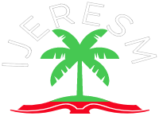International Journal of Emerging Research in Engineering, Science, and Management
Vol. 4, Issue 3, pp. 52-59, Jul-Sep 2025.
https://doi.org/10.58482/ijeresm.v4i3.8
This work is licensed under a Creative Commons Attribution 4.0 International License.
Rationalization of Next-Generation GST Reforms: Enhancing Ease of Doing Business and Economic Competitiveness
Satish M Dhoke
Associate Professor, Department of Commerce, Moreshwar Arts Science and Commerce College, Bhokardan Dist., Jalna, Maharashtra, India.
Abstract: India’s Goods and Services Tax, introduced in 2017, was envisioned as a transformative reform to unify indirect taxation and foster competitiveness. However, compliance burdens, multiple tax slabs, and frequent rule changes continue to limit efficiency. This study examines the impact of next-generation GST reform, including compliance simplification, slab rationalization, and digital automation, on the ease of doing business and competitiveness, with a focus on enterprises in the state of Maharashtra. A mixed-methods design combined survey data from 200 GST-registered businesses with expert interviews. Findings indicate that rationalization significantly improves operational efficiency, reduces transaction costs, and strengthens competitiveness, with digital automation emerging as the strongest predictor. The study concludes that GST rationalization is not merely an administrative adjustment but a strategic imperative for India’s economic growth.
Keywords: GST Rationalization, Ease of Doing Business, Digital Automation, Tax Slab Reform, Economic Competitiveness, MSMEs.
References:
- M. Keen, “The anatomy of the VAT,” IMF Working Paper, vol. 13, no. 111, p. 1, Jan. 2013, doi: 10.5089/9781484330586.001.
- Government of India, “The Central Goods and Services Tax Act, 2017,” Ministry of Law and Justice, New Delhi, India, Act No. 12 of 2017.
- M. G. Rao, “Evolving issues and future directions in GST reform in India,” ideas.repec.org, Jul. 2022, [Online]. Available: https://ideas.repec.org/p/mad/wpaper/2022-221.html
- C. Evans and R. Krever, “Taxing capital gains: a comparative analysis and lessons for New Zealand,” The UWA Profiles and Research Repository, Dec. 01, 2017. https://research-repository.uwa.edu.au/en/publications/taxing-capital-gains-a-comparative-analysis-and-lessons-for-new-z
- NUS Law, “Singapore Master Tax Guide 2024-25, 43rd Edition – NUS Law,” NUS Law, May 10, 2024. https://law.nus.edu.sg/publications/singapore-master-tax-guide-2024-25-43rd-edition/
- “VAT in the Digital Age (VIDA),” Taxation and Customs Union, Sep. 24, 2025. https://taxation-customs.ec.europa.eu/taxation/vat/vat-digital-age-vida_en
- “Tax Administration 2021,” OECD, Sep. 15, 2021. https://www.oecd.org/en/publications/2021/09/tax-administration-2021_72b221d1.html
- M. C. Purohit, “Issues in the introduction of goods and services tax,” Economic and Political Weekly, vol. 45, no. 5, pp. 12–15, 2010, [Online]. Available: https://www.jstor.org/stable/25664058
- Sacchidananda Mukherjee, “Issues of Compliance in GST,” Economic and Political Review, Vol. 54, Issue No. 47, 30 Nov, 2019.
- “Impact of GST on MSME’s.” https://www.yesbank.in/business-banking/yes-gst/knowledge-articles/impact-of-gst-on-msmes
- “NITI Aayog releases report on ‘Designing a Policy for Medium Enterprises.’” https://www.pib.gov.in/PressReleasePage.aspx?PRID=2131261
- “GST and Fiscal Federalism,” Drishti IAS. https://www.drishtiias.com/daily-news-editorials/gst-and-fiscal-federalism
- “India Inc. embraces GST: 85 percent of respondents show positive sentiment as industry charts path for GST 2.0 — Deloitte GST@8 Survey,” Deloitte. https://www.deloitte.com/in/en/about/press-room/india-inc-embraces-gst.html
- Annapoorna, “Impact of GST on manufacturing sector: Reforms, benefits & challenges,” Cleartax, Jun. 03, 2025. https://cleartax.in/s/impact-of-gst-on-manufacturing-sector
- M. Porter, The competitive advantage of nations. Harvard Business Review, 1989.
- R. M. Bird and P.-P. Gendron, “Sales Taxation in Canada: The GST-HST-QST-RST ‘System,’” SSRN Electronic Journal, Jan. 2009, doi: 10.2139/ssrn.1413333.
- A. Stokes and S. Wright, “Does Australia have a good income tax system?,” International Business & Economics Research Journal (IBER), vol. 12, no. 5, p. 533, Apr. 2013, doi: 10.19030/iber.v12i5.7828.
- World Bank, Doing Business 2020: Comparing Business Regulation in 190 Economies. Washington, DC: World Bank, 2020. doi: 10.1596/978-1-4648-1440-2.
- “Paying Taxes 2020,” World Bank. https://archive.doingbusiness.org/en/reports/thematic-reports/paying-taxes-2020
- Toomas Kästik, “The Impact of Digital Governance on the Business Environment: the Case of Estonian Tax and Customs Board,” In Proceedings of the 12th International Conference on Theory and Practice of Electronic Governance, Association for Computing Machinery, New York, NY, USA, pp. 472–474, 2019. doi: 10.1145/3326365.3326430
- M. I. Islam, K. U. Nisa, S. Mufti, S. I. Ansarullah, S. Ikhlaq, and T. Yousuf, “Artificial intelligence in tax compliance,” in IGI Global eBooks, 2025, pp. 251–270. doi: 10.4018/979-8-3373-0422-9.ch011.
- J. Alm, “Measuring, explaining, and controlling tax evasion: lessons from theory, experiments, and field studies,” International Tax and Public Finance, vol. 19, no. 1, pp. 54–77, Apr. 2011, doi: 10.1007/s10797-011-9171-2.
- “Economic Survey of Maharashtra 2024-25 | Finance Department | India.” https://finance.maharashtra.gov.in/en/publication/economic-survey-of-maharashtra-2023-24/
- R. V. Krejcie and D. W. Morgan, “Determining sample size for research activities,” Educational and Psychological Measurement, vol. 30, no. 3, pp. 607–610, Sep. 1970, doi: 10.1177/001316447003000308.
- O. E. Williamson, “Transaction Cost Economics,” in Springer eBooks, 2008, pp. 41–65. doi: 10.1007/978-3-540-69305-5_4.
- Oliver E. Williamson, “The Economics of Organization: The Transaction Cost Approach,” American Journal of Sociology, vol. 87, no. 3, 1981, doi: 10.1086/227496.
© 2025 The Author(s). Published by IJERESM. This work is licensed under the Creative Commons Attribution 4.0 International License.
Archiving: All articles are permanently archived in Zenodo IJERESM Community.
